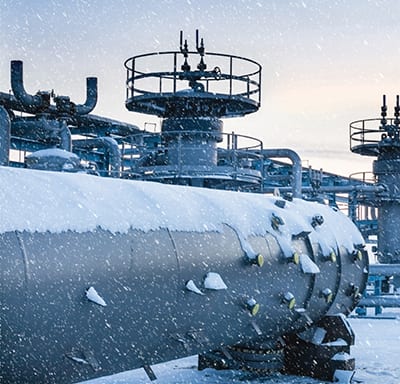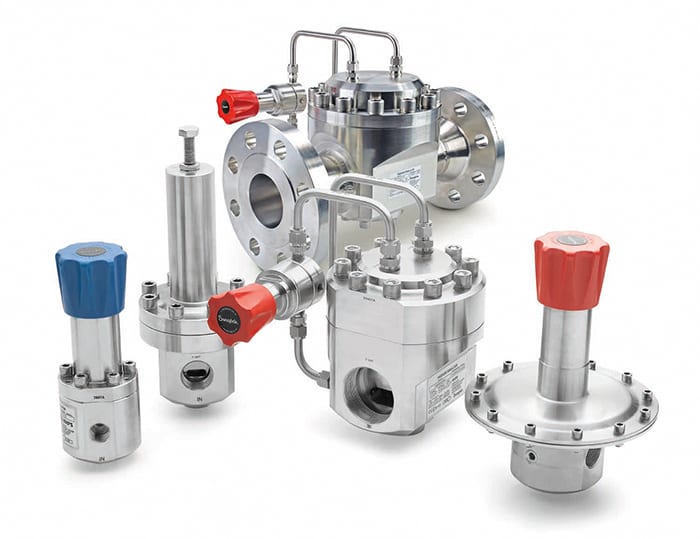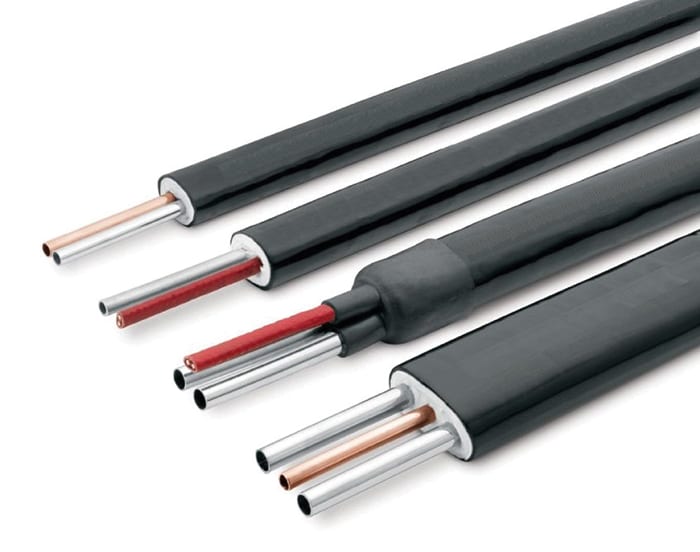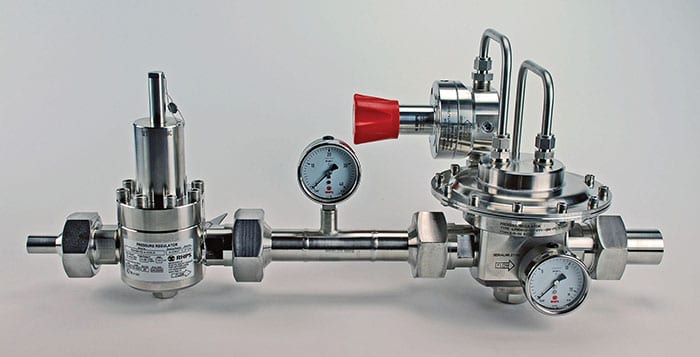In low-temperature conditions, the use of compatible sealing materials is essential for leak-tight operation and proper functionality of pressure-regulating devices
Harsh, frigid conditions are among the most challenging industrial environments (Figure 1) for fluid-handling applications. At these temperatures, it is especially difficult to ensure proper, leak-tight operation of fluid-system components. Elastomeric sealing materials inside components can harden, crack and simply stop performing when temperatures drop too low. Therefore, at extremely low temperatures, valves, regulators and many other components may not fully seal, causing leaks. Additionally, the components may become difficult, if not impossible, to actuate.

FIGURE 1. Industrial facilities in cold climates face a host of challenges when it comes to preventing fluid leaks
Ensuring sound low-temperature performance can be especially difficult within dynamic fluid-system components like pressure-reducing regulators (Figure 2), which are commonly found in many gas-supply applications. When such applications take place in northern climates like those found in Alaska, Canada, Siberia, northern Europe and the Arctic Ocean where temperatures may dip to –40°F (–40°C) or colder, sensitive regulator components can become less responsive as temperatures drop. If engineers and operators do not specify the appropriate materials of construction for the regulator’s sealing elements, onsite technicians may need to constantly tend to the components, which can be tough to manage in frigid conditions.

FIGURE 2. Various regulators can perform reliably in extremely low-temperature conditions when engineers specify the appropriate materials of construction for the regulator’s sealing elements
Beyond the challenges of operating in cold environments, pressure-reducing regulators can also create low-temperature conditions of their own when regulating gas pressure. As a regulator reduces the pressure of a gas, the gas can lose significant heat due to the thermodynamic relationship of pressure and temperature — a phenomenon known as the Joule-Thomson effect. The temperature drop may be so drastic that the regulator ices over. The regulator’s sealing elements will need to perform reliably in this situation to ensure both sealing and operation.
To confirm that a regulator will deliver leak-tight sealing and function properly at extremely cold ambient temperatures, engineers and operators must carefully choose sealing materials that meet the lowest temperatures anticipated during service. They should also ensure that the regulator manufacturer has tested the regulator at low temperatures using those materials to avoid any surprises.
Regulators in cold conditions
Common low-temperature regulator applications include industrial- or bulk-gas supply configurations that are located outdoors. Such systems may supply large volumes of gas or liquefied gas to a facility, with the liquified gas first being converted into a gas via vaporization. Such gas supplies are generally located outside of facilities for safety reasons, as well as for delivery logistics, so that tanker trucks can easily refill the gas cylinders or bulk tanks outdoors. The cylinders, tanks and associated gas lines are not typically climate-controlled, meaning that components can be exposed to the elements. Exposure to extreme temperatures can affect regulator performance in two ways: their ability to seal properly; and their ability to control pressure effectively.
Sealing mechanisms within regulators are most often made of various elastomeric materials. Such materials are prone to shrinking and hardening as temperatures drop. As a result, the elasticity the materials exhibited at warmer temperatures diminishes, making it more difficult to create a positive seal. At colder temperatures, the elastomers deform barely, if at all, when making contact with sealing elements, such as the poppet or diaphragm inside a regulator. This reduces their sealing ability. Furthermore, at low temperatures, the elastomers may even reach their glass transition temperature (Tg), at which point they become especially brittle. The resulting hard surface may no longer provide a positive seal. In either case, system fluid may escape past the shrunken, hardened sealing materials and either escape to atmosphere or creep across the regulator’s seat from the high- to low-pressure areas of the regulator under no-flow conditions.
The functionality challenges that a low-temperature operation presents for regulators is also related to elastomeric hardening. As elastomers stiffen, it can be more difficult for dynamic elements within a regulator to move freely. It may therefore be difficult for the regulator’s poppet to move out of its valve seat as pressure demands call for this action. Any slow response may cause system flow through the regulator to become restricted. In addition, downstream pressure may drop further than desired, or at least be inconsistent as the regulator’s sensing element attempts to react to system changes while encountering restricted movement.
The best way to address the limitations that low-temperature conditions present to regulator performance is to select elastomeric sealing materials that can withstand the lowest temperatures anticipated during operation. In addition, the lubricants applied to sealing mechanisms should be chosen for reliable operation in cold temperatures.
Pressure drops effect cooling
Environmental conditions aside, regulators that are used to reduce gas pressure face the risk of experiencing drastic cooling through the course of their normal operation due to the Joule-Thomson effect. When a gas is forced through a narrow opening to reduce its pressure, such as what occurs within a pressure-reducing regulator’s seat, the gas temperature will drop drastically on the downstream side where the gas expands. This is true for all real gases, except helium, hydrogen and neon (unless the real gases reach their inversion temperature point, at which they get hotter during expansion, instead of cooling down). Conversely, most liquids will warm up when passing through the same constricted flow path.
With the Joule-Thomson effect, the temperature change of a gas is proportional to the amount of pressure drop on the downstream side of the regulator. Depending on the pressure drop, the temperature drop experienced when throttling a gas could be so severe that the regulator itself will ice over. Exterior ice can form around the regulator’s low-pressure outlet connection as moisture from the surrounding air condenses on the metal. Ice can also form inside the regulator’s bonnet, and any ice buildup there can prevent free movement of the regulator’s sensing elements, including its spring and diaphragm, or sealing elements, such as the the piston or poppet. Regulator icing can occur even at warmer temperatures, but it presents a greater threat to regulator performance in low-temperature environments, because the regulator’s internal components are more likely to become restricted in extremely cold conditions.
To mitigate freezing on both the inside and outside of a regulator, plant engineers can arrange to heat the process line or even the regulator. Process line heating may involve placing heat tracing or insulation on lines (Figure 3). Alternatively, a heated enclosure can be installed around the regulator. When doing so, engineers must account for the higher heat when selecting sealing materials for the regulator to ensure that the materials will not deform from the additional heat.

FIGURE 3. One option to mitigate regulator freezing as a result of the Joule-Thomson effect is to heat the process lines using heat tracing
Another option to mitigate the Joule-Thomson effect is to reduce the gas pressure in two stages using a two-stage regulator setup (Figure 4). In such a system, the first pressure regulator would handle the majority of the pressure drop and cooling, while the second pressure regulator would manage the fine control. This type of setup can be tuned to avoid icing in many situations, but rarely in conditions where ambient temperatures are extremely cold.

FIGURE 4. Reducing gas pressure in two stages, as shown in this configuration, can also help to mitigate the Joule-Thompson effect
Just like the strategy for enhancing regulator performance in cold temperatures, the solution to addressing issues related to Joule-Thomson effect cooling is to choose regulator sealing materials that will perform at low temperatures. Doing so will minimize leak potential and help to ensure regulator operation.
Selecting sealing materials
When operating regulators, any cooling — whether due to ambient temperature drops or internal thermodynamics — that dips below the performance temperature limit of the regulator’s elastomer sealing materials increases the likelihood that the regulator will not seal properly during operation. Therefore, operators must carefully select materials of construction for all of a regulator’s sealing mechanisms, which may include the following: the seat seal, which seals high inlet pressure from reaching the low-pressure side of the regulator; dynamic seals, such as where the regulator’s poppet seats into its body; seals for sensing elements, such as elastomeric diaphragms or piston O-ring seals; and any static seals that seal the regulator components together to contain internal pressure (Figure 5).

FIGURE 5. When specifying a regulator for low-temperature service, all of the regulator’s elastomer sealing mechanisms should be rated for the service environment. This includes the following: the regulator’s seat seal; dynamic seals, such as where the regulator’s poppet seats into its body; seals for sensing elements, such as elastomeric diaphragms or piston O-ring seals; and any static seals
Within a regulator, any of the aforementioned seals could be made of an elastomeric material, such as butyl rubber, fluoroelastomer (FKM), nitrile rubber or a wide array of other materials. However, diaphragm sensing mechanisms may sometimes be made from polytetrafluoroethylene (PTFE), and seat seals may sometimes feature harder materials like polychlorotrifluoroethylene (PCTFE) or polyether ether ketone (PEEK).
Elastomers are rubber-like polymers that maintain flexibility above their Tg temperatures, enabling positive sealing in a wide range of applications. Below their Tg, elastomers become brittle and can even crack or break, potentially causing sealing failures. As elastomers cool, they also shrink. The process is known as temperature retraction (TR). When considering appropriate elastomers for low-temperature service, component manufacturers typically focus on the material’s tested TR-10 limit, which designates the point at which the elastomer has retracted, or shrunken, 10% after being stretched and frozen according to testing protocols. This point is a preliminary indicator of the material’s lower-temperature limit and can be used when making sealing material selections. As an elastomer approaches its TR-10 limit, it begins to behave more like soft plastic than rubber, but should still maintain reliable positive sealing. As the material cools further, it approaches its Tg temperature, at which point it may no longer maintain a seal because it has hardened too much to deform at sealing contact points.
Selecting an appropriate elastomer for low-temperature regulator applications will depend on the lowest temperature limits anticipated for the component’s service. For example, when anticipating outdoor temperatures of –40°F, operators may opt to use nitrile seals, as the material has been confirmed to perform at this temperature via laboratory testing. Nitrile is a good choice because it is a popular elastomer that performs well in low temperatures, and many compounds of nitrile are compatible with a wide range of applications, including low-temperature service for applications containing hydrocarbon mixtures. Numerous other options are available, but operators will need to verify the low-temperature performance and chemical compatibility of those materials based on the application. For example, ethylene propylene diene monomer (EPDM) also works well at low temperatures, but may not have acceptable chemical compatibility with hydrocarbons.
Verifying sealing performance
Installing a regulator for low-temperature service should not represent a risk for a chemical plant, petroleum refinery or other operation. Therefore, despite confirming the low-temperature performance of an elastomer based on charts developed from laboratory testing, it is advisable for those materials to be tested within the actual components in which they will be used. Without performing leak and functional tests, the manufacturer — not to mention the operator — cannot know if the regulator will deliver the expected results.
A regulator manufacturer should perform various tests using a particular material to help verify the anticipated real-world performance of the component. The testing should be robust enough to confirm not only that the regulator will seal and not leak at very low temperatures, but that the regulator will also operate (control pressures) at those temperatures.
Testing the regulator’s sealing capabilities can be accomplished via the following two common tests:
Seat leak test.By applying low and high pressures to a regulator at extremely low temperatures, the manufacturer will be able to determine if the regulator’s sealing elements are able to fully seal and not allow pressure and system fluid to escape to the outlet side under no-flow conditions — a phenomenon known as creep.
Shell leak test.With the regulator’s internal components energized, manufacturers can test the component at extremely low temperatures to confirm that no internal pressure is leaking to atmosphere.
These two tests could be considered “seal and survive” tests, as they can prove that a material is able to provide a sufficient leak-tight seal at reduced temperatures. It is helpful for such tests to include a series of temperature cycles — going from room temperature to low temperature or high temperature several times — to confirm how the material reacts to fluctuating temperature stresses. Simply testing the material one time at a cold temperature does not necessarily prove its performance.
While these tests are helpful to verify a regulator’s sealing performance, they do not provide insight into how the regulator will actually perform at low temperatures. While the regulator may seal sufficiently at –40°F (–40°C), for example, it may have a high actuation torque — or not be able to actuate at all — because the elastomeric O-ring surrounding the poppet is too stiff to move. The act of actuating the regulator at a low temperature may even damage sealing surfaces, creating leaks. Therefore, manufacturers should expand their testing protocols to also include functionality testing.
For functional testing, manufacturers should test components under various temperature cycles, as well as pressure cycles. Temperature cycling accomplishes the same goals as in sealing testing — to verify performance based on fluctuating temperatures. Testing functionality at various pressures is important because a leak at a low pressure may seal at a higher pressure. It is important to know if this may occur so that operators can anticipate this possibility in the field.
Operators should select regulators and sealing materials carefully to ensure that their components can be used across a broad range of temperatures and pressures, and will not just “seal and survive” in cold climates and applications where significant cooling occurs due to high pressure drop, but also perform reliably in those conditions.
Edited by Mary Page Bailey
Author
 Jon Kestner is product manager, general industrial regulators at Swagelok Co. (31500 Aurora Rd., Solon, OH 44139; [email protected]). Kestner is responsible for assessing competitive positioning, as well as creating development and commercialization plans for the product line. He also educates end users on best practices for regulator installation, operation, troubleshooting and maintenance via training sessions and contributions to the Swagelok Reference Point blog (www.swagelok.com/blog). Kestner joined Swagelok in 2009 as a technical service representative and has also had roles as an inside technical sales engineer and field engineer. He holds a bachelor’s degree in mechanical engineering from Tufts University.
Jon Kestner is product manager, general industrial regulators at Swagelok Co. (31500 Aurora Rd., Solon, OH 44139; [email protected]). Kestner is responsible for assessing competitive positioning, as well as creating development and commercialization plans for the product line. He also educates end users on best practices for regulator installation, operation, troubleshooting and maintenance via training sessions and contributions to the Swagelok Reference Point blog (www.swagelok.com/blog). Kestner joined Swagelok in 2009 as a technical service representative and has also had roles as an inside technical sales engineer and field engineer. He holds a bachelor’s degree in mechanical engineering from Tufts University.